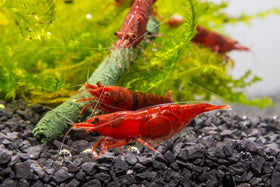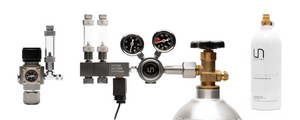
Top 10 Fast-Growing Plants to Combat Algae
Live aquatic plants don't just make your aquarium look better—did you know they naturally help fight against algae in planted tanks?
In fact, the more plants in your tank, the better positioned you are to combat algae outbreaks in the future. Plants that grow quickly compete for light and nutrients—while outperforming algae in the process. These fast-growing plants play an important role in maintaining water quality by absorbing excess nutrients like nitrate and phosphate, which are compounds algae need to grow.
This means less time battling algae outbreaks—and more time enjoying a crystal-clear aquarium!

Beyond managing algae, fast-growing plants offer other benefits to your fish tank. These plants improve your aquarium's water quality by absorbing harmful compounds like ammonia and nitrite. This helps balance water chemistry and makes maintenance easier by preventing sudden spikes of toxic substances. Live aquatic plants also improve water quality by absorbing carbon dioxide and producing oxygen!
Additionally, aquatic plants create a natural environment for breeding fish. They offer safe areas for adults to lay eggs, for fry to hide, and help foster the growth of microorganisms that serve as crucial food sources for newly hatched fry.
In this article, we'll discuss the top 10 fastest-growing aquarium plants. These plants can help control algae, stabilize water conditions, and offer shelter for fish in your freshwater tank.

1. Salvinia Natans
Salvinia Natans, also known as Floating Fern, is a fast-growing floating fern with unique nickel-sized leaves and a fuzzy texture. Unlike other floating plants, this plant doesn't have lengthy roots that trail into the water column. Instead, it forms dense mats on the water's surface, effectively blocking out light penetration below. Its rapid growth not only provides shelter for tank inhabitants, the plant also outcompetes algae for light, reducing the risk of algae blooms and promoting a balanced environment in your aquarium.

2. Red Root Floaters
Red Root Floaters are a popular floating plant species that feature blood-red roots and undersides. Under high lighting, its leaves can turn completely red! Not only are they a visually striking addition to your aquarium, but they're also an effective weapon against algae.
Red Root Floaters propagate quickly and create a dense canopy on the water's surface, shading lower levels of the tank and depriving algae of the light they need to grow. Additionally, with their long roots, Red Root Floaters are excellent at absorbing excess nutrients and toxic compounds from the water, further inhibiting algae growth and promoting a healthier ecosystem.

3. Java Moss
Java Moss is a staple in the aquarium hobby for its ease of care and versatile nature. Unlike some plants, it flourishes without the need for CO2 supplementation or high-intensity lighting. Though while it will grow in almost all lighting conditions, for dense moss growth, use bright lights.
This fast-growing moss can form dense clusters and mats that provide excellent hiding spots for fry and breeding fish. For species that disperse their eggs, its fine fronds provide an ideal surface for attachment, while its delicate branched structures offer effective camouflage against potential predators.

4. Rotala Narrow Leaf Sp. Red
Rotala Narrow Leaf Sp. Red is a popular stem plant that features narrow leaves and vibrant red foliage. Once established, Rotala variants are fast-growing plants, and in a high-light and nutrient-rich environment, it can easily grow 1-2 inches a week, so you'll need to frequently trim the plant to prevent overgrowth and shading of lower portions.
Propagation is the same as other Rotala species and aquatic stem plants in general. Just snip along the stem and replant it into aquasoil!

5. Egeria Densa
Egeria Densa, also known as Anacharis or Elodea, is a fast-growing leafy stem plant that is highly effective at absorbing excess nutrients from the water column, effectively depriving algae of the resources they need to grow. This prevents future algae outbreaks. This is a great plant to help stabilize a new aquarium from the start. Additionally, its dense growth pattern provides shade and shelter for all tank inhabitants.

6. Hygrophila Difformis
Hygrophila Difformis, commonly known as Water Wisteria, is one of the most popular fast-growing plants due to its rapid growth rate and beginner-friendly care requirements. While it has the potential to grow tall, regular pruning allows for a compact and low-growing appearance. Additionally, its fast growth rate allows for easy propagation through stem cutting and replanting, which increases its appeal to aquarists looking to increase their tank's plant volume and density as quickly as possible.

7. Bacopa Caroliniana
Bacopa Caroliniana, with its thick green leaves and upright growth habit, is a beautiful choice for planted aquariums. The plant is usually green, but new growth can turn reddish with the addition of iron and other nutrients. Bacopa variants grow faster with CO2 supplementation, bright lighting, and access to essential nutrients, but growers can still cultivate this hardy plant without any supplementation.

8. Hydrocotyle Leucocephala
Hydrocotyle Leucocephala, also known as Brazilian Pennywort, is a well-known fast-growing plant with round, penny-sized leaves that look like clovers. It is popular for its undemanding nature and rapid plant growth, which makes it effective against algae because it rapidly consumes excess nutrients in the water column.
It can out-compete other plants for light and become overgrown if not regularly trimmed. To maintain a low-growing, carpeting appearance in the foreground, you should trim new growth frequently and provide sufficient light with CO2 supplementation.

9. Vallisneria Gigantea 'Rubra'
Vallisneria Gigantea Rubra stands out as a distinctive variety within the Vallisneria genus, featuring long leaves that can develop a reddish hue. As a background freshwater plant, it exhibits rapid and towering growth, which means it effectively competes with algae due to its high nutrient demands. Vals plants propagate through side shoots and can quickly reach the height of your aquarium. Its fast growth rate and dense foliage create a lush environment that shades the aquarium and promotes a stable, algae-free ecosystem for all tank inhabitants.

10. Pearl Weed
Pearl Weed, also known as Hemianthus Micranthemoides, is a popular fast-growing carpeting plant that grows in dense bunches of low-growing stems. Its rapid growth rate and lush foliage make it an effective competitor against algae. As a foreground plant, Pearl Weed can quickly overtake your tank if you don't keep up on regular trimming.
With bright light and CO2 injection, Pearl Weed grows sideways to form a carpet instead of growing upwards. This spreading behavior occurs rapidly, allowing Pearl Weed to cover large areas of the substrate in a relatively short amount of time. Its an excellent plant for absorbing toxic ammonia and nitrate in the water for the prevention of algae outbreaks.
 Harnessing the Power of Fast-Growing Plants to Tackle Algae
Harnessing the Power of Fast-Growing Plants to Tackle Algae
In conclusion, adding fast-growing aquatic plants to your aquarium offers a ton of advantages. These plants play a pivotal role in managing the occurrence of stubborn algae so you can spend less time fighting outbreaks and more time enjoying your aquarium!
Additionally, these plants actively consume ammonia and nitrite, contributing to enhanced water quality and stability within the tank. Finally, fast-growing plants foster a safe environment for breeding fish by offering plenty of hiding places and coverage for fry, which significantly boosts their survival rate.
Beyond their functional benefits, these live plants also add natural beauty to any planted tank, mirror the natural habitats of various aquarium fish species, and encourage your fish to interact with their environment. As a result, introducing the plants we've discussed to your freshwater aquarium can greatly elevate your success in warding off algae and maintaining a balanced aquarium.
Tell us - Was this article helpful? Please leave a comment below!
If you have any questions regarding this article, please email support@buceplant.com, or DM us on Instagram or Facebook so we can assist you directly - @buceplant





Leave a comment